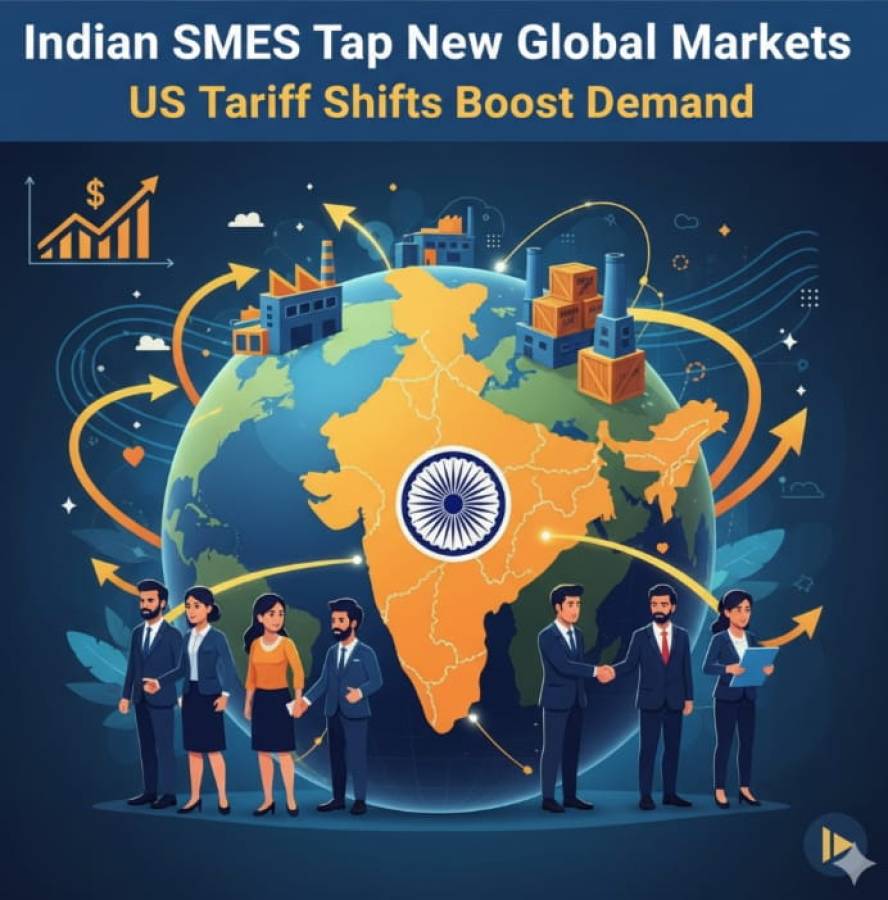
Indian small and medium enterprises (SME) are discovering unexpected opportunities in global trade as shifting tariff policies in the United States create new gaps in supply chains. What began as a challenge for many exporters has slowly turned into a chance to enter markets that were earlier difficult to access. Indian entrepreneurs are now stepping into spaces where suppliers from other countries are struggling to cope with rising costs. This shift is helping a wide range of Indian products reach buyers in Europe, the Middle East, South America, New Zealand and several Asian regions.
Many SME owners explain that buyers abroad are currently searching for reliable and cost effective alternatives to Chinese goods. American tariffs on Chinese imports have pushed prices up for several categories of products. As a result, many international buyers are exploring new sourcing destinations. India has become one of the strongest options in this search because it offers competitive prices and consistent quality across sectors such as handicrafts, garments, engineering goods, leather and lifestyle products.
A recent delegation of Indian SMEs visited multiple countries to exhibit their products and meet new buyers. According to participants, the response was far better than they expected. Several business owners received bulk orders for items such as hand carved wooden pieces, artisanal décor items, traditional garments and small engineering components. Many buyers were keen on long term partnerships after comparing Indian prices with those of their usual suppliers.
Entrepreneurs also shared stories of how new markets opened up almost suddenly. A handicraft manufacturer from Uttar Pradesh said that his products, which earlier struggled for attention, are now receiving interest from buyers in Brazil and Chile. A garment maker from Jaipur reported that retailers in New Zealand and Australia are looking for stable suppliers who can deliver good design and dependable quality without steep price hikes. These kinds of stories reveal how global shifts can change the fortunes of small enterprises that are ready to adapt.
Industry bodies and export councils are now actively helping SMEs make full use of this moment. Programs that connect Indian exporters with overseas buyers are being strengthened in collaboration with state and central government agencies. Many states are supporting these efforts by identifying promising local enterprises and preparing them for global exhibitions. Training on packaging, product presentation, digital catalogues and international pricing is also being offered so that SMEs can meet global expectations.
The National Small Industries Corporation and other similar organisations have organised large exhibitions in cities like Delhi to match Indian producers with foreign buyers. These events allow small manufacturers to display everything from home décor to metal parts. Several business owners said that this kind of direct interaction helps them understand what international buyers want, which allows them to improve designs and packaging before finalising orders.
One of the most notable outcomes has been the signing of multiple agreements for supply partnerships. Many of these agreements involve orders of thousands of pieces or ongoing monthly supply commitments. For small firms, such deals give stability and a predictable source of income. They also encourage companies to improve manufacturing processes and maintain better quality control because international clients expect consistency.
However, while the opportunities are significant, experts explain that SMEs must strengthen their long term readiness. To take full advantage of the shift in global supply chains, Indian firms need stronger logistics, more modern production systems and faster adaptation to global standards. Challenges such as shipping delays, raw material shortages and slow adoption of technology can reduce the gains that SMEs are currently enjoying.
Another point of concern is that global demand may shift again in the future. Tariff policies do not always remain the same. Indian businesses need to build trust with foreign buyers so that partnerships continue even if global conditions change. Building strong branding, offering transparent communication and meeting timelines can help SMEs secure a long lasting place in the international market.
Despite these concerns, the current moment represents one of the most promising phases for Indian SMEs in recent years. The combination of global policy changes, rising demand for alternatives and India’s growing manufacturing strength has created a unique window of opportunity. If SMEs continue to innovate and deliver reliable quality, they can establish themselves as key players in the global supply chain.




















